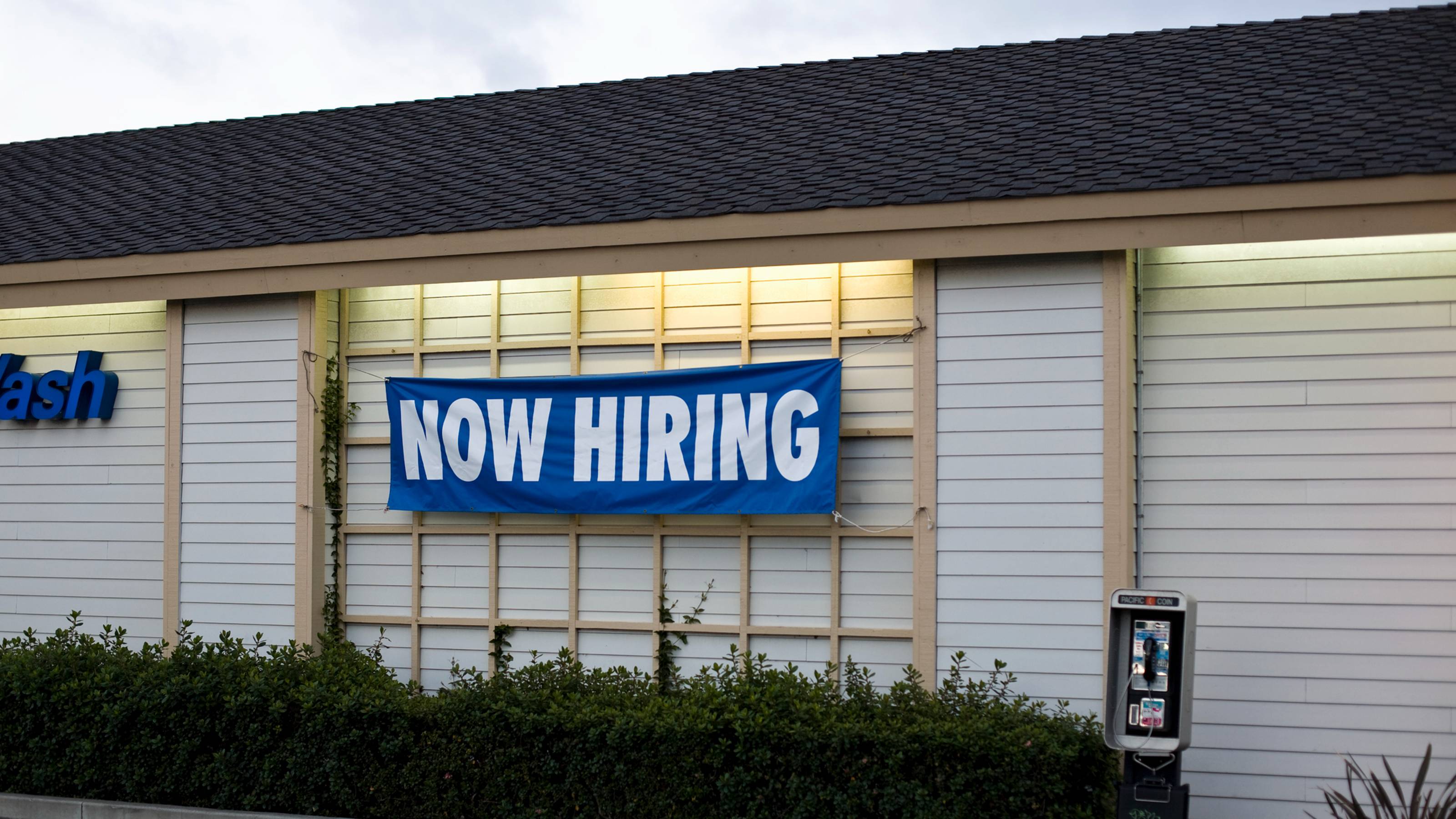
The April jobs report topped economists' expectations by a wide margin and the unemployment rate ticked down to remain at 50-year lows, complicating the Federal Reserve's mission to rein in inflation.
Total nonfarm payroll employment rose by 253,000 in April, the Bureau of Labor Statistics said Friday, well ahead of economists' forecast for the addition of 185,000 new jobs. The unemployment rate, which is derived from a separate survey, slipped to 3.4% from 3.5% in March, remaining at levels not seen in half a century. Economists expected the unemployment rate to rise to 3.6%.
The main areas of job growth included professional and business services, healthcare, leisure and hospitality, and social assistance, the BLS said.
The economy has added an average 290,000 new jobs a month over the past six months, defying the Fed's efforts to introduce slack into a squeaky tight labor market.
Also confounding the Fed was the fact that April's average hourly earnings rose 0.5%. Over the past year, average hourly earnings have increased by 4.4%, per the BLS.
If there was a bright spot for Fed policy, it's that payroll employment for March and February were revised downward. Taken together, employment for both months was 149,000 lower than previously reported.
Market participants are hopeful that the central bank will adopt what is being called a "hawkish pause" at the next Fed meeting, bringing an end to the most aggressive campaign of interest rate hikes in 40 years.
At the most recent Fed meeting, which wrapped up on May 3, Chair Jerome Powell made it clear that future policy moves will be "data dependent." The April jobs report, at first blush, would appear to be a data point that argues against a pause in interest rate hikes.
With the April jobs report now a matter of record, we turned to economists, strategists, investment officers and other experts to get their takes on what the data means for markets, macroeconomics and monetary policy going forward. Below please find a selection of commentary, sometimes edited for clarity or brevity.
Jobs report: the experts weigh in

"April came in hot, with a big upside to jobs created and an increase in hourly wages compared to expectations. The bond market is selling off as it was pricing in a rate cut as early as this summer. I don't believe that anything in this report can be considered confirmatory that the economy is about to decline. The only bond positive information is from the March jobs report being revised lower by the same amount that April exceeded expectations. These revisions underscore that the jobs report should not be considered biblical truth, but more directional in nature, and one should look at several months together." – Rhys Williams, chief strategist at Spouting Rock Asset Management
"Big payroll gains, higher wages and lower unemployment maintain the narrative of an economy that still needs to hire. The structural demand for workers shows little sign of letting up. Jerome Powell still has little reason to pause. Attention will now focus on Treasury yields, which were squeezed into a tight range before the news." – David Russell, vice president of market intelligence at TradeStation
"While today's report of 253,000 jobs gained was quite a bit stronger than consensus estimates, material downward revisions of nearly 150,000 jobs for February and March temper this beat somewhat. This was a mixed report, consistent with a slowing labor market in the most cyclical areas, but not a weak one overall." – Rick Rieder, chief investment officer of global fixed income at BlackRock
"This report will keep the Fed on its toes as it prepares to discuss its next move during the Federal Open Market Committee [FOMC] scheduled for June 13 to 14." – Eugenio Alemán, chief economist at Raymond James
"The Fed will bristle at the tighter labor market conditions, pickup in payrolls and work hours, and stronger wage growth (especially after that awful Q1 unit labor cost report), but it should take some comfort from the overall moderating trend in employment. Given its newfound desire to hold to the sidelines after 5 percentage points of rate hikes, the onus is likely on the 'totality' of the data to spur another move in June. Upside surprises in the CPI and/or consumer spending reports could warrant more action. But for now, we'll stick with a view that the economy is losing momentum and core inflation is at least grinding down, keeping the expected pause intact." – Sal Guatieri, senior economist at BMO Capital Markets
"We continue to expect a pause at the June meeting because of tighter credit conditions, the restrictive level of the funds rate, and Powell's view that the May FOMC statement represents a 'meaningful change.'" – Jan Hatzius, chief economist at Goldman Sachs
"Today's jobs report could change the view that a recession is imminent and lead to even more investor uncertainty, in both equity and bond markets. Strong job gains and low unemployment may signal that inflation is not over just yet. This is also on top of decent Q1 earnings. That continued uncertainty could translate into more negative sentiment and higher volatility, especially as we won't hear from the Fed again for several weeks." – Melissa Brown, managing director of applied research at Qontigo
"This labor market is stronger, and tighter than it was a year ago. The number of people employed over the past year is up 3 million, or 1.9%, and wages are up 4.4%. Total unemployed since last year is down 311,000, or 5.2%. That's likely why we see such a sudden rise in AI. There aren't enough people to get the job done, and AI is one avenue businesses are exploring to fill in the gaps." – Andrew Crapuchettes, CEO of RedBalloon
"Interest rates are going to have to remain elevated. This kind of strength in the labor market makes it more difficult for the Fed to continue its reduction in inflation. What this means is inflation may drag on a little longer and so will higher interest rates." – Sean Snaith, director of the University of Central Florida's Institute for Economic Forecasting
"April was another good month for job growth, which established yet another 50-year low for the unemployment rate. However, significant downward revisions to prior month job gains temper the outlook. This report shows that despite threats from the debt ceiling standoff and banking sector stress, the real economy keeps motoring along. Meanwhile, the absence of a major inflationary impulse will reassure the Fed that it can safely pause rate hikes." – Curt Long, chief economist at the National Association of Federal Credit Unions
"While the Fed's rate hikes have begun to impact earnings growth and create instability in the banking sector, U.S. employment continues to surprise to the upside. The Fed indicated that it may be ready to pause further action after their 10th consecutive rate hike hit earlier this week, but the signals from the labor market are fighting back and may cause some investors to reshape their near-term market expectations." – Ben Vaske, investment strategist at Orion Portfolio Solutions
"While the jobs market has remained incredibly resilient, clouds continue to gather. Hiring momentum has slowed, with deteriorating demand for workers pointing to more pronounced weakening ahead. We look for job growth to slow more meaningfully in the second half of the year and into 2024 as the lagged effect of monetary policy tightening bites." – Sarah House, senior economist at Wells Fargo Economics
"The data ratify the view that the Fed, assuming it does pause, will not be pivoting any time soon." – David Rosenberg, founder and president of Rosenberg Research
"The strong result indicates that the labor market remained resilient during the month despite uncertainty created by the recent high profile bank failures. This supports a Fed pause at the June FOMC meeting, as the strength of the labor market should help calm market calls for rate cuts." – Sam Millette, fixed income strategist at Commonwealth Financial Network







